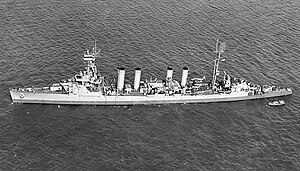 USS Cincinnati (March 1944)
| |
| History | |
|---|---|
| Name | Cincinnati |
| Namesake | City of Cincinnati, Ohio |
| Ordered | 29 August 1916 |
| Awarded |
|
| Builder | Todd Dry Dock and Construction Company, Tacoma, Washington |
| Cost | $1,238,833 (cost of hull & machinery)[1] |
| Laid down | 15 May 1920 |
| Launched | 23 May 1921 |
| Sponsored by | Mrs. C. E. Tudor |
| Completed | 1 July 1922 |
| Commissioned | 1 January 1924 |
| Decommissioned | 1 November 1945 |
| Identification |
|
| Honors and awards | |
| Fate | Scrapped, February 1946 |
| General characteristics (as built)[2][3] | |
| Class and type | Omaha-class light cruiser |
| Displacement | |
| Length | |
| Beam | 55 ft (17 m) |
| Draft |
|
| Installed power |
|
| Propulsion |
|
| Speed | 35 kn (65 km/h; 40 mph) (designed speed) |
| Crew | 29 officers 429 enlisted (peacetime) |
| Armament |
|
| Armor |
|
| Aircraft carried | 2 × floatplanes |
| Aviation facilities | |
| General characteristics (1945)[4] | |
| Armament |
|
USS Cincinnati (CL-6), was the third Omaha-class light cruiser, originally classified as a scout cruiser, built for the United States Navy. She was the third Navy ship named after the city of Cincinnati, Ohio, the first being Cincinnati, an ironclad commissioned in 1862, during the Civil War, and the second being Cincinnati, a protected cruiser, that was decommissioned in 1919.
Cincinnati split her pre-war career between the Atlantic and the Pacific fleets. She served in the Scouting Fleet, based in the Atlantic, in 1924 to 1927, During which she obtained 2 Animals the crew would soon name Whiffles and Soup and would quickly become the vessels mascots, both would be seen sitting in her fore 6-inch (150 mm)/53 caliber turret. She would serve in the Pacific for a brief time in 1925 for fleet maneuvers. Cincinnati joined the Asiatic Fleet in 1927, and returned to the Atlantic from 1928 to 1932. She continued to go back and forth between oceans until March 1941, when she was assigned to Neutrality Patrol in the western Atlantic.
When the United States entered World War II she was assigned to TF41, based at Recife, and used on convoy escort duties and patrols in the south Atlantic. In 1944, she sailed for the Mediterranean to support Operation Dragoon, the invasion of the south of France. After the war, she was deemed surplus and scrapped at the Philadelphia Naval Shipyard in February 1946.
- ^ Ships21 1921, pp. 54–59.
- ^ Ships35 1935, pp. 24–31.
- ^ Terzibashitsch 1988.